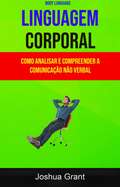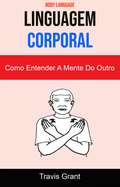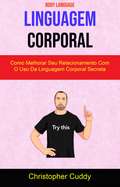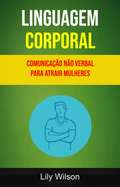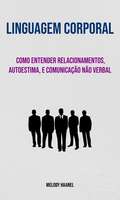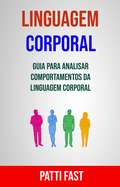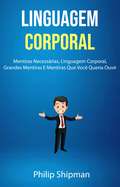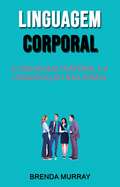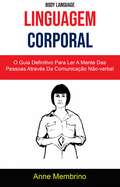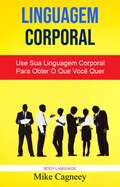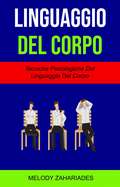- Table View
- List View
Linguagem Corporal: As Habilidades da Linguagem Corporal para Detetar Mentiras e Ler Qualquer Pessoa
by Judi WongAs pessoas, os amigos, membros da sua família, colegas de trabalho, vendedores, mentem-nos a toda a hora. Diária e constantemente. Nenhum de nós está imune, e todos somos vítimas. De acordo com vários estudos, levados a cabo, por diferentes pesquisadores, todos nós somos vítimas de em média 200 mentiras por dia. Você está prestes a descobrir que o objetivo da linguagem corporal é ler a mensagem que o corpo quer transmitir, independentemente das palavras. Em alguns casos, o corpo mostra a mesma atitude ou sentimentos que estão a ser passados através da linguagem verbal, das palavras, noutros casos, o corpo envia-nos uma mensagem diferente. Uma boa razão para continuar a ler este livro, é entender que a linguagem corporal representa uma alta proporção do significado da mensagem, quando alguém verbaliza algo.
Linguagem Corporal: As Melhores Dicas Para Melhorar Sua Linguagem Corporal ( Body Language )
by Carol ClarkNeste guia, você aprenderá a promover melhores relacionamentos, comunicar-se efetivamente, estabelecer metas para o futuro, adotar uma perspectiva mais contente, feliz e positiva e, o mais importante, controlar as emoções negativas e orientar sua própria mente, sem influências externas. Este livro explicará a você como funciona a linguagem corporal e como entender melhor o que as outras pessoas estão dizendo com seus movimentos e expressões corporais.
Linguagem Corporal: Como Analisar E Compreender A Comunicação Não Verbal ( Body Language)
by Joshua GrantVocê gostaria de dominar a comunicação não-verbal e a linguagem corporal dos outros? Ao contrário da crença comum, aprender a ler a linguagem corporal não é difícil. A Linguagem Corporal 101 pega você pela mão e mostra como qualquer um pode ler os sinais indicadores da linguagem corporal e, com isso, saber o que a outra pessoa está REALMENTE pensando ao contrário do que ela pode estar dizendo. As habilidades que você aprenderá neste livro melhorarão enormemente suas interações sociais e relacionamentos, sejam negócios ou prazeres. Este livro ajudará você a entender e colocar em prática diferentes tipos de comunicação não verbal. Usando os princípios e as instruções deste livro, você aprenderá os melhores tipos de linguagem corporal para usar em diferentes tipos de situações sociais. Baixe este grande livro hoje!
Linguagem Corporal: Como Aprender Comunicação Não Verbal
by James CainPessoas mentem, mas existe uma coisa que nunca mente: seus corpos. Linguagem corporal: Como aprender comunicação não verbal Alguns pesquisadores provaram que a linguagem corporal transmite a maior parte das informações na interação interpessoal. Ela regula interações e mantém relacionamentos. Porém, linguagem corporal também é ambígua. Assim sendo, é importante a leitura correta da linguagem corporal para evitar erros na compreensão. Entender como ler e dar sugestões não verbais é uma parte importante da comunicação. Nós o fazemos automaticamente sem saber e o entendimento é a palavra chave. Mesmo assim, se você quer dominar linguagem corporal para manipulação dos outros, será mais provável que você falhe e perca confiança no final. Não espere para descobrir a SUA CHAVE para uma vida nova e melhor.
Linguagem Corporal: Como Entender A Mente Do Outro ( Body Language )
by Travis GrantSe você quer aprender sobre Analisar Pessoas ou se já tem alguma noção e deseja adquirir conhecimentos extras para fazer tudo o que for possível para conseguir ler pessoas, este livro é para você. Você irá se surpreender com o quanto pode aprender e com a consciência que irá atingir com todos os benefícios. Impressione seus amigos e familiares com o quanto de psicologia humana você consegue ler neles!
Linguagem Corporal: Como Melhorar Seu Relacionamento Com O Uso Da Linguagem Corporal Secreta ( Body Language )
by Christopher CuddyVocê gostaria de descobrir o que está acontecendo dentro da cabeça de outra pessoa? O autor cobre tudo, desde gestos e posturas até espaço pessoal e físico. Desde os tempos antigos, usamos nossa linguagem corporal para nos comunicar, transmitindo nossas emoções e pensamentos para aqueles que nos rodeiam. Cada pessoa tem uma linguagem corporal diferente, englobando não apenas expressões faciais, mas também posturas e gestos corporais. Mesmo o movimento dos olhos é considerado como parte da comunicação não verbal, sendo seguido de perto pelo toque e pelo uso do espaço pessoal. Se você está pronto para agir e mudar sua vida para melhor, este livro definitivamente o guiará na direção certa!
Linguagem Corporal: Como Reconhecer Sinais Vitais Em Qualquer Situação
by Charles DelfinoLinguagem Corporal: Como reconhecer sinais vitais em qualquer situação por Charles Delfino Domine a arte da linguagem corporal! Você não percebe a existência da sombra do corpo humano na maior parte do tempo. Você também não sabe o que acontece quando você vai dormir. Não importa onde você esteja ou o que está fazendo, sua sombra irá e fará o mesmo. A linguagem corporal é uma ferramenta poderosa que pode ser usada em todos os aspectos da sua vida. Este livro lhe dará uma visão aprofundada sobre como ler a linguagem corporal para decifrar as informações ocultas de qualquer diálogo ou interação. Além de te ensinar como e quando usá-la. Dominando as habilidades deste livro você poderá melhorar seu relacionamento com seu cônjuge, parceiro e membros da família, assim como melhorar sua carreira ajudando-o a aceitar essa entrevista ou ajudá-lo a construir um relacionamento sólido com seus colegas de trabalho ou chefe. Se você está pronto para tomar uma atitude e mudar sua vida para melhor, este livro definitivamente irá guiá-lo na direção certa! Gênero: NEGÓCIOS E ECONOMIA / Gestão Gênero Secundário: AUTOAJUDA / Geral Contagem de palavra: 15096 Informações de vendas: Recentemente fizemos uma promoção e conseguimos fazer 1.500 vendas durante o período da promoção. Embora todas as vendas fossem de downloads gratuitos, significa que o tema tem potencial e é capaz de gerar receita. Os downloads pagos variam entre 40 e 60 por mês. Cálculo Estimativa mínima - 30 downloads pagos *US$ 3,00 * 70% =US$ 63 por mês Máximo, mas não limitado a - 60 downloads pagos *US$ 3,00 * 70% =US$ 126 por mês Lucro anual por livro - Estimativa mínima - US$ 63 * 12 = US$ 756 por ano. Lucro anual por livro - Máximo, mas não limitado a Estimativa - US$ 126 * 12 = US$ 1512 por ano. Por favor, observe que este é
Linguagem Corporal: Comunicação Não Verbal Para Atrair Mulheres
by Lily WilsonEntender a linguagem corporal melhora a sua comunicação, o que vai diminuir os seus conflitos internos, a linguagem corporal é uma grande jogada nos tempos atuais, e também se mostra muito importante para alavancar sua carreira. Depois de ler esse pequeno livro você irá conseguir conquistar a garota que você ama, apenas se colocando em uma posição dominante ou andando como um homem de verdade. O que você está esperando? Não espere mais nada. Compre esse livro e entre na jornada dos seus sonhos.
Linguagem Corporal: Descubra Como Atrair As Pessoas Usando O Poder Da Linguagem Corporal
by Rebecca ThompsonVocê está prestes a descobrir os diferentes aspectos da linguagem corporal e técnicas que vão lhe permitir ler os gestos, ações e emoções dos outros. Você também pode tentar usar esses gestos e expressões você mesmo para interagir com amigos e familia. Enquanto você desenvolve essa habilidade usando os segredos, truques e estratégias que você vai encontrar nesse livro, você será capaz de acelerar o seu sucesso nos negócios e relacionamentos de todos os tipos.Você já sentiu como se o que alguém está lhe dizendo não fosse o que a pessoa realmente sente? O que Você está esperando? Não espere mais! Role para cima e clique no botão comprar agora para começar a jornada para a vida dos seus sonhos!
Linguagem Corporal: Dominando A Arte Da Comunicação Não-verbal
by Victoria WilsonA linguagem corporal nem sempre é tão óbvia ou expressiva quanto a capa deste livro. A maior parte da nossa linguagem corporal é sutil e expressada em micro expressões. Ao entender as pistas não-verbais que outras pessoas nos enviam, nós entenderemos melhor as mensagens e a situação, permitindo-nos reagir e abordá-las da maneira mais apropriada. Se mais pessoas puderem perceber e entender melhor como os outros se sentem em relação a elas, e o significado real daquilo que estão tentando transmitir, elas poderão ajustar seu comportamento e suas reações. Deste modo, aumentarão suas chances de fazer mais conexões sociais com os outros ao seu redor. Faça o Download deste Grande Livro Hoje!
Linguagem Corporal: Domine a Arte De Ler Qualquer Um Através Da Comunicação
by James CainPense em como seria ÓTIMO impressionar as pessoas com seus movimentos, seu posicionamento, seu andar… sem ao menos dizer uma única palavra! Você pode aprender a ler as várias maneiras de linguagem corporal nas mãos, pernas, olhos e rostos das pessoas. Esta habilidade é especialmente útil se você estiver interessado em conseguir um encontro. Linguagem corporal: domine a arte de ler qualquer um através da comunicação guia você pelo processo de chamar alguém para sair, se encontrar com a pessoa, e ler seus sinais corretamente no quarto. O que você está esperando? Chega de esperar! Role para cima e clique em “comprar” agora para começar a jornada para a vida dos seus sonhos!
Linguagem Corporal: Guia Para A Leitura Da Comunicação Não Verbal ( Body Language)
by Jennifer BradberryAcredite ou não, a maior parte de nossa comunicação é na verdade não verbal. Ou seja, a maior parte do que estamos dizendo expressa-se através de nossos movimentos, postura, expressões e ações. Essa forma coletiva de comunicação é conhecida como linguagem corporal. Compreender os princípios básicos da comunicação não verbal passa a ser uma questão muito importante para os estudantes deste campo. Entretanto, filtrar quais as orientações mais apropriadas para alcançar esse objetivo pode parecer ser trabalho algo complicado hoje em dia, pois existem centenas de livros sobre o assunto, todos oferecendo apresentações diferentes do mesmo assunto. Esta descrição multifacetada da mesma ideia passa a servir como guia para a redação deste livro. Não espere mais tempo para descobrir a sua chave para uma vida nova e melhor.
Linguagem Corporal: Guia Para Analisar Comportamentos Da Linguagem Corporal
by Patti FastVocê já se perguntou por quê algumas pessoas você desgosta imediatamente e outros que você tende a procurar sempre? Obviamente, existe algo mais acontecendo além da comunicação verbal que te atrai ou te repele, correto? Você pode descobrir o que isso é lendo o nosso livro. Dentro das páginas do livro, você aprenderá sobre os quatro principais tipos de personalidade e até determinar em qual delas você se encaixa. Linguagem Corporal revela as reais intenções das pessoas. Ainda assim, a maioria de nnós desconhece como identificar e ler esses gestos sutis. A maioria não entende que o corpo envia sinais que falam bem mais alto que as palavras. Baixe Sua Cópia hoje!
Linguagem Corporal: Guia Prático Para Aprender Tudo Sobre Linguagem Corporal
by Mark SeglerVocê raramente da uma pausa para considerar como usar os gestos de suas mãos, seus olhos, postura do corpo, toque e espaço mas essas são maneiras poderosas de se comunicar através da linguagem corporal o tempo todo. Quando nós tratamos de comunicação eficaz, nada funciona melhor em favor de um ser humano do que a combinação da linguagem verbal com a não verbal, isso te leva aonde você quer chegar. Qual é a diferença entre essas duas formas de comunicação? Aprender a como entregar a melhor primeira impressão possível e ter uma grande influência nos outros. Descubra o que significam os movimentos mais comuns no corpo e aprenda também a interpretar sentimentos, pensamentos e claras intenções. Compre sua cópia ainda hoje!
Linguagem Corporal: Guia Simples De Domínio, Elevação De Status E Comunicação Não Verbal ( Body Language)
by Brian LevineEste livro tem a capacidade de mudar totalmente sua vida. Você aprenderá quais sinais de linguagem corporal deve procurar quando quiser saber se a pessoa com quem está falando está dizendo a verdade ou está tentando te enganar. Ele sempre lhe dará essa vantagem para que você possa ajustar o seu plano de jogo, direcionando as coisas na direção que VOCÊ precisa. Este livro ajudará você a entender e usar diferentes tipos de comunicação não-verbal. Usando os princípios e as instruções deste livro, você aprenderá os melhores tipos de linguagem corporal para usar em diferentes situações sociais. O que você está esperando? Não espere mais! Role para cima e clique no botão "Comprar agora" para começar a jornada para a vida dos seus sonhos!
Linguagem Corporal: Guia ilustrado para Entender Comunicação Não Verbal
by Joe PaigeQuando conversamos nós falamos muito pouco porque é o nosso corpo que realmente conversa! Nós nos expressamos muito inconscientemente através do nosso comportamento físico, postura, gestos, movimento dos olhos, expressões faciais, toque e o espaço que usamos. Então por que não aprender como usar isso a nosso favor? Linguagem corporal é uma poderosa ferramenta que pode ser usada em todos os aspectos da sua vida. Este livro lhe trará um conhecimento profundo sobre como interpretar a linguagem corporal e decifrar as verdadeiras intenções de qualquer dialogo ou interação. Dominar as habilidades que estão nesse livro irá melhor seus relacionamentos com sua esposa, parceiro ou membros da família, e pode até mesmo avançar sua carreira ajudando-o a se sair bem naquela entrevista ou a construir bons relacionamentos com seus colegas de trabalho ou chefe. Praticando esses princípios você será capaz de aprimorar muitos aspectos da sua vida como relacionamentos, carreira e sua vida social de modo geral. Obtenha sua cópia hoje clicando no botão no alto desta página
Linguagem Corporal: Linguagem Corporal: Mentiras Necessárias, Linguagem Corporal, Grandes Mentiras E Mentiras Que Você Queria Ouvir
by John MarketComo uma forma de comunicação não verbal, a linguagem corporal é necessária para comunicar pensamentos, sentimentos e intenções através de expressões faciais, toque, movimentos dos olhos, festos e postura corporal. A linguagem corporal não á linguagem de sinais, mas uma linguagem completa usada para comunicar e entender os sentimentos e intensões dos membros das sua família e dos seus colegas. A linguagem corporal não usa interpretação e gramática. O significado da linguagem corporal pode depender do movimento em si. Em toda sociedade, um comportamento particular é usado para a interpretação da linguagem corporal. Se você quer aprender linguagem corporal, esse livro pode ser útil para você.
Linguagem Corporal: Linguagem corporal e como isso pode criar resultados incríveis em todas as áreas da sua vida!
by Brenda MurrayUm movimento errado pode acabar com sua mensagem. Acredite ou não, nossos corpos falam mais alto que nossas palavras. Posturas, gestos e expressões contém muita informação – e geralmente não é o que você esperar. Um sorriso, por exemplo, é usualmente considerado acolhedor. Mas levante um pouco um canto da sua boca mais alto e você projetará superioridade, subconscientemente afastando as pessoas. E se depois de ler esse pequeno guia, você consiga atrair a garota que você quer, apenas sentando em uma posição DOMINANTE ou andar como um fodão? O que você está esperando? Não espere mais! Arraste para cima e clique o botão de comprar agora para começar sua jornada para a vida dos seus sonhos!
Linguagem Corporal: O Guia Definitivo Para Ler A Mente Das Pessoas Através Da Comunicação Não-verbal ( Body Language)
by Anne MembrinoA linguagem corporal, também conhecida como comunicação não-verbal, é a forma como nos expressamos através de gestos, expressões, postura, tom, contato visual, ritmo de fala, e muito mais. Se você já ouviu a expressão “as ações falam mais alto do que as palavras”, você já ouviu uma verdade universal. Aprenda a deixar a melhor primeira impressão possível, e exerça uma grande influência sobre os outros. Descubra o que os hábitos e movimentos mais comuns do corpo significam e interprete sentimentos, pensamentos e intenções com precisão. Adquira sua cópia hoje, clicando no botão no topo desta página!
Linguagem Corporal: Que tal ser capaz de ler as emoções de qualquer pessoa sem que ela diga uma única palavra?
by Rebecca ThompsonEste livro pode te oferecer uma persepção prática das pistas não verbais e o que elas significam. A informação nesse livro pode te ajudar a entender como a sua própria linguagem corporal afeta as outras pessoas e a sua própria psiquê e decidir se você está mandando a mensagem que quer mandar.E a respeito daqueles oradores públicos que lhe deixam na beirada da sua cadeira com sua boca aberta ou os seus olhos bem abertos? Você está enfeitiçado apenas pelas palavras que eles estão dizendo? Absolutamente não. A comunicação não verbal faz parte de todo aquele pacote que eles estão lhe dando. Como eles andam no palco. o que eles fazem com suas mãos e braços. Como eles dobram ou esticam seu corpo ou se estendem. suas expressões faciais à medida que eles falam. É tudo um pacote de acordo a se transformar no que o seu público chama de um orador carismático.
Linguagem Corporal: Um Guia Inteligente Para Entender a Linguagem Corporal (Auto-ajuda: Body Language)
by Jennifer ConstantineEste é um manual surpreendente e revelador contendo tudo o que alguém precisa saber sobre a linguagem corporal. Com isso, você poderá se tornar um verdadeiro detector de mentiras humanas, identificando exatamente quando as pessoas estão falando a verdade, quando estão mentindo e até mesmo como estão se sentindo. O que você pode dizer sobre braços cruzados, a distância que alguém fica ao falar com você, expressões faciais ou olhos piscando? Quase tudo! Com centenas de exemplos, o Lingugem Corporal para Iniciantes poderá ajudar qualquer pessoa, de qualquer cultura, a saber mais sobre seus amigos, cônjuge, colegas, amantes, competidores e inimigos. Você sabia que seu corpo fala muito mais alto que suas palavras? A maneira como você move seus olhos, boca, cabeça, braços e pernas - tudo isso tem significado.
Linguagem Corporal: Um guia perfeito para a interação humana
by Jennifer JamesEste livro leva o leitor a uma visita guiada pelo subconsciente das interações humanas. Quando ouvimos falar em "comunicação das pessoas", frequentemente pensamos em comunicação verbal. E é apenas o topo do iceberg. A linguagem verbal como outras características humanas se desenvolveu em um processo evolutivo longo e complicado. A linguagem verbal pode ser chamada de filho da linguagem não verbal.
Linguagem Corporal: Use Sua Linguagem Corporal Para Obter O Que Você Quer ( Body Language )
by Mike CagneeyEm qualquer situação de comunicação com alguém, você dá sinais não-verbais. Eles podem ser gestos, a maneira que sentamos, um toque no braço e muitas outras coisas diferentes que fazemos ao longo de nossa comunicação. Enquanto nós todos entendemos a comunicação não-verbal inconscientemente, aprender a usar a linguagem corporal forma consciente não dará apenas uma melhor compreensão de outras pessoas - mas também, um melhor controle em outros aspectos da vida. Toda estratégia é simples e fácil de seguir, permitindo a realização de exercícios para tentar e inspirar confiança, conversas motivacionais entre duas pessoas, te ajudando a dar o empurrão necessário para fazer as mudanças que vão revolucionar a sua vida para melhor.
Linguaggio Del Corpo : Padroneggiare L'arte Della Comunicazione Non Verbale
by Andrea EspositoIl linguaggio del corpo non è sempre così ovvio ed espressivo come rivela la copertina di questo libro. La maggior parte del nostro linguaggio del corpo è sottile ed è espresso in micro espressioni. Comprendendo i segnali non verbali che le altre persone ci inviano, comprenderemo meglio i messaggi e le situazioni, permettendoci di reagire e affrontarli in modi più appropriati. Se più persone sono in grado di percepire e capire meglio come si sentono gli altri e il significato reale di ciò che stanno cercando di trasmettere, possono adattare il loro comportamento e le reazioni di conseguenza. Pertanto, aumentando le loro probabilità di creare più connessioni sociali con gli altri.
Linguaggio Del Corpo : Tecniche Psicologiche Del Linguaggio Del Corpo
by Melody ZahariadesAvete mai sognato di sapere cosa stanno pensando e provando gli altri solo osservandoli? Imparare ad analizzare gli altri vi avvantaggerà nella vita sociale, privata e professionale. L'ottanta per cento della comunicazione umana è in realtà non verbale, e alcuni esperti affermano che potrebbe essere persino più di così. Il linguaggio del corpo è considerato un elemento fondamentale della comunicazione non verbale, poichè viene usato consapevolmente e inconsapevolmente per interagire con gli altri. Spesso si dice che il linguaggio del corpo serva a completare la nostra comunicazione verbale. Attraverso la nostra postura, i gesti e le espressioni trasmettiamo numerose informazioni su di noi al nostro interlocutore.


